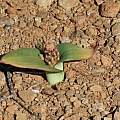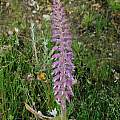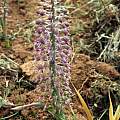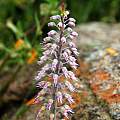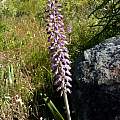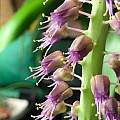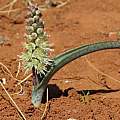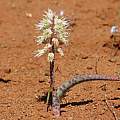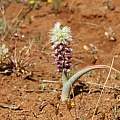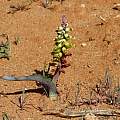Lachenalia is a genus with bulbs in the Hyacinthaceae family found in Namibia and South Africa. There are around 133 species. A complete illustrated systematic monograph of this genus by Graham Duncan, The Genus Lachenalia, was published in 2012. Lachenalia species d-i are found on this wiki page.
Lachenalia a - Lachenalia b-c - Lachenalia j-n - Lachenalia o-p - Lachenalia q-t - Lachenalia u-z - Polyxena - Lachenalia index
Lachenalia doleritica G.D.Duncan has two ovate leaves with recurved tips and bell-shaped flowers that are yellowish green with darker tips. It grows on dolerite flats in the Roggeveld and flowers September to October, growing 12-18 cm high. The first two photographs were taken by Mary Sue Ittner September 2006 early morning near Middelpos. Photos three and four were taken by Alan Horstmann. The last photo was taken by Rod Saunders.
Lachenalia elegans W.F.Barker grows near Nieuwoudtville. It has one or two lanceolate leaves and flowers that are blue at the base, shading to rose with brown gibbosities and white protruding inner segments with a pale pink spot near the tips. Height range: 10-30 cm. Many of the varieties broadly grown were elevated to species level in 2012 when Graham Duncan published his latest book on this genus. Photos below by Rod Saunders and Cameron McMaster could be what is left of this species.
Lachenalia elegans var. flava W.F.Barker was changed to Lachenalia karoopoortensis G.D.Duncan
Lachenalia elegans var. membranacea W.F.Barker was elevated to Lachenalia membranacea (W.F.Barker) G.D.Duncan
Lachenalia elegans var. suaveolens W.F.Barker was elevated to Lachenalia suaveolens (W.F.Barker) G.D.Duncan
Lachenalia fistulosa Baker grows on rocky mountain slopes in the north and southwest Cape and blooms in spring. This species has two plain or spotted brown leaves and sessile cream, yellow, blue, lilac or violet scented bell-shaped flowers, growing 8-30 cm tall. The first three photos were taken by Mary Sue Ittner of plants she has grown from seed. The last three pictures from Andrew Harvie were taken in habitat at Silvermine and Lion's Head in Table Mountain National Park.
Lachenalia flava Andrews has been known by many different names. Synonyms are Lachenalia aloides var. aurea (Lindl.) Engl., Lachenalia aurea Lindl., Lachenalia macrophylla Lem., Lachenalia quadricolor var. lutea Sims, and Lachenalia tricolor var. aurea (Lindl.) Hook.f. Plants grow 19 to 25 cm tall with two lanceolate leaves that can be plain or spotted. The many flowered inflorescence is racemose and erect with a dull purple to maroon or light green with large purple splotches scape. Long lasting flowers are tubular, pendulous, dark golden-yellow or orange with the apex light to bright golden orange. Stamens are included. Flower time in habitat is from July to October. Flowers are adapted to pollination by sunbirds. Photo 1 was taken by Jana Ulmer. Photos 2-5 by Mary Sue Ittner. The first two show the flowers and the leaves of plants grown from wild seed collected near Paarl and the last two volunteers in her garden.
The first three photos were taken by Nhu Nguyen. Photo 1 shows a form with green tepal tips. Photo 2 shows a closeup of another form. Photo 3 shows a dramatic display of orange! Photos 4 and 5 show plants in cultivation by Richard Sullivan. The last photo below was taken in habitat near Bainskloof by Andrew Harvie.
Lachenalia framesii W. F. Barker is a Namaqualand species that grows in flat sandy areas, often in large colonies. This is a delightful small species with a quite striking inflorescence consisting of greenish yellow outer perianth segments and protruding inner segments that have recurved magenta tips; it grows to about 15 cm tall. It flowers in the period between the third week in August and the second week in October. Description from Don Journet. The first two photos from Alan Horstmann. The last two were taken near Knersvlakte September 2011 by Cameron McMaster.
Lachenalia giessii W.F.Barker is distributed in Namibia and the Northern Cape, South Africa where it grows in a number of different habitats. It is a dwarf species (3.5 to 16 cm) with white scented flowers. It flowers July to September. Photos from Bert Zaalberg.
Lachenalia gillettii W.F.Barker was proposed to be included in Lachenalia pallida Aiton in Graham Duncan's 2012 book. It is found in clay soils in the northwest Cape near Piketberg and Citrusdal. Growing from 12 to 22 cm high, it has two strap-shaped leaves and shortly pedicellate, narrowly bell-shaped, white and lilac flowers with green markings. The anthers are exserted. The inner segments have magenta tips. Flowering is from August to September. Photos by Mary Sue Ittner of plants that were grown from seed that are supposed to be this species.
Lachenalia glauca (W.F.Barker) G.D.Duncan, syn. Lachenalia violacea var. glauca W.F.Barker, is distributed in Namaqualand where it grows singly or in large populations on flats, granite outcorps or mountainsides in sandy granitic soils or sandy clay. It flowers in spring from mid-September to early October and is pollinated by honey bees. Growing from 15 to 35 cm high, it has 1 to 2 narrowly to broadly lanceolate, glaucous to light green leaves that clasp the leaf bases. The many-flowered raceme has oblong-campanulate flowers, grey-blue at the base, shading to pale magenta with slightly darker gibbosities with well exserted stamens. It differs from Lachenalia violacea in a shorter perianth tube, greyish-mauve tepals, white or greyish-mauve filaments, coconut scent, and unmarked usually narrower leaves. The first three photos were taken in Namaqualand September 2006 by Mary Sue Ittner. The last photo from Cameron McMaster was also taken in Namaqualand.
The first two photos below were taken by Richard Sullivan of plants in cultivation almost 30 cms tall, flowering in April in Northern California with a very strong coconut fragrance. The next two were taken by Rimmer de Vries.
Lachenalia glaucina Jacq. was elevated from Lachenalia orchioides ssp. glaucina (Jacq.) G.D.Duncan in Duncan, G.D. (2023), Four new species and three taxonomic adjustments in Lachenalia (Asparagaceae: Scilloideae) from southern and western South Africa. Phytotaxa 585 (4): 261–273. See link. At the end of 2025 World Flora Online is still listing it as a subspecies of Lachenalia orchioides.
Lachenalia glaucophylla W.F. Barker is a small flowered, dwarf species that grows from 7 to 11 cm. It is found in Namaqualand and in the Roggeveld. It has a single, grey-green curved leaf that is spotted on the outside. The white bell shaped flowers are spice-scented and pollinated by bees. The stamens are well exserted. It flowers in October (spring). Photos below were taken by Alan Horstmann in the Roggeveld.
Lachenalia haarlemensis Fourc. grows on stony clay slopes in the southeast Cape. It has one or two leaves banded with maroon and greenish gray bell-shaped flowers that are shortly pedicellate with exserted mauve stamens. Height range: 12-22 cm. Flowering is from September to October. The first two photos from Mary Sue Ittner. The last photo from the book Plants of the Klein Karoo courtesy of Jan and Anne Lise Schutte-Vlok.
Lachenalia hirta (Thunb.) Thunb. is distributed from Namaqualand to the Western Cape where it grows in sandy soil, often in large colonies. Generally, the flowers do not make this species stand out in a collection as the colours are not vivid, but it is nonetheless quite charming. The flowers have outer perianth segments that are pale blue at their base shading to yellow with brown gibbosities. The single narrow leaf of this species is striking in the strong purple horizontal banding towards the base and the hairs on the margins and reverse of the side (hence the name hirta). Description from Don Journet. Height: 10-30 cm. The first two photos taken by Mary Sue Ittner September 2006 in Namaqualand show the flowers and the unusual leaf. The rest of the photos were taken by Cameron McMaster near Darling in the West Coast and Spoegrivier in Namaqualand.
Photos below by Colin Davis show striking floral coloration (true colors) and leaf undulation.
Lachenalia inflata G.D.Duncan was described in Duncan, G.D. (2023), Four new species and three taxonomic adjustments in Lachenalia (Asparagaceae: Scilloideae) from southern and western South Africa. Phytotaxa 585 (4): 261–273. See link. In that paper it was described as being from the Hantam-Roggeveld escarpment in the western Great Karoo (Northern Cape). Photos from Alan Horstmann. The last two were taken in the Roggeveld. World Flora Online at the end of 2025 lists this species as unchecked.
Lachenalia isopetala Jacq. is found on dolerite flats in the northwest Cape and the Roggeveld. Growing from 10 to 30 cm high, the species has two lanceolate leaves, often dry at flowering and shortly pedicellate brown to maroon flowers. Flowering is from October to November. Photos by Alan Horstmann and Rod Saunders.
Lachenalia a - Lachenalia b-c - Lachenalia j-n - Lachenalia o-p - Lachenalia q-t - Lachenalia u-z - Polyxena - Lachenalia index


